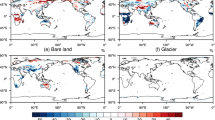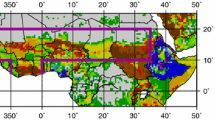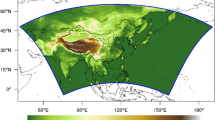Abstract
This study assesses the sensitivity of the fully coupled NCAR-DOE PCM to three different representations of present-day land cover, based on IPCC SRES land cover information. We conclude that there is significant model sensitivity to current land cover characterization, with an observed average global temperature range of 0.21 K between the simulations. Much larger contrasts (up to 5 K) are found on the regional scale; however, these changes are largely offsetting on the global scale. These results show that significant biases can be introduced when outside data sources are used to conduct anthropogenic land cover change experiments in GCMs that have been calibrated to their own representation of present-day land cover. We conclude that hybrid systems that combine the natural vegetation from the native GCM datasets combined with human land cover information from other sources are best for simulating such impacts. We also performed a prehuman simulation, which had a 0.39 K ~higher average global temperature and, perhaps of greater importance, temperature changes regionally of about 2 K. In this study, the larger regional changes coincide with large-scale agricultural areas. The initial cooling from energy balance changes appear to create feedbacks that intensify mid-latitude circulation features and weaken the summer monsoon circulation over Asia, leading to further cooling. From these results, we conclude that land cover change plays a significant role in anthropogenically forced climate change. Because these changes coincide with regions of the highest human population this climate impact could have a disproportionate impact on human systems. Therefore, it is important that land cover change be included in past and future climate change simulations.



















Similar content being viewed by others
References
Alcamo J (ed) (1994) IMAGE 2.0: integrated modeling of global climate change. Kluwer, Dordrecht, pp 318
Alcamo J, Leemans R, Kreileman E (eds) (1998) Global change scenarios of the 21st century. Results from the IMAGE 2.1 model. Pergamon, London, pp 296
Ammann CM, Meehl GA, Washington WM, Zender CS (2003) A monthly and latitudinally varying volcanic forcing dataset in simulations of 20th century climate. Geophys Res Lett 30(12):1657, DOI 10.1029/2003GL016875
Avissar R (1995) Recent advances in the representation of land-atmosphere interactions in general circulation models. Rev Geophys 33:1005–1010, DOI 10.1029/95RG00258
Bonan G (1994) Comparison of two land surface models using prescribed forcings. Journal of Geophysical
Betts RA (2001) Biogeophysical impacts of land use on present-day climate: near-surface temperature and radiative forcing. Atmos Sci Lett 2: 39–51, DOI 10.1006/asle.2001.0023
Bonan GB (1996) A land surface model (LSM version 1.0) for ecological, hydrological, and atmospheric studies: technical description and user′s guide. NCAR Technical Note NCAR/TN-417+STR. National Center for Atmospheric Research, Boulder, Colorado, pp 150
Bonan GB (1997) Effects of land use on the climate of the United States. Clim Change 37:449–486. DOI 10.1023/A:1005305708775
Bonan GB (1998) The land surface climatology of the NCAR land surface model coupled to the NCAR Community Climate Model. J Clim 11(6):1307–1326. DOI 10.1175/1520–0442(1998)011<1307
Bonan GB (1999) Frost followed the plow: impacts of deforestation on the climate of the United States. Ecol Appl 9(4):1305–1315
Bonan GB (2001) Observational evidence for reduction of daily maximum temperature by croplands in the Midwest United States. J Clim 14(11):2430–2442. DOI 10.1175/1520–0442(2001)014<2430
Bonan GB, Oleson KW, Vertenstein M, Levis S, Zeng X, Dai Y, Dickinson RE, Yang Z (2002) The land surface climatology of the community land model coupled to the NCAR Community Climate Model. J Clim 15(22):3123–3149. DOI 10.1175/1520–0442(2002)015<3123
Boone A, Habets F, Noilhan J, Clark D, Dirmeyer P, Fox S, Gusev Y, Haddeland I, Koster R, Lohmann D, Mahanama S, Mitchell K, Nasonova O, Niu G-Y, Pitman A, Polcher J, Shmakin AB, Tanaka K, van den Hurk B, Vérant S, Verseghy D, Viterbo P, Yang Z-L (2004) The Rhô ne-aggregation land surface scheme intercomparison project: an overview. J Clim 17(1):187–208. DOI 10.1175/1520–0442(2004)017<0187
Bounoua LR, DeFries R, Collatz GJ, Sellers P, Khan H (2002) Effects of land cover conversion on surface climate. Clim Change 52:29–64. DOI 10.1023/A:1013051420309
Brovkin V, Ganopolski A, Claussen M, Kubatzki C, Petoukhov V (1999) Modelling climate response to historical land cover change. Global Ecology and Biogeography 8:509–517
Chase TN, Peilke Sr. RA, Kittel TGF, Nemani RR, Running SW (2000) Simulated impacts of historical land cover changes on global climate in northern winter. Clim Dyn 16(2–3):93–105. DOI 10.1007/s003820050007
Chen TH, Henderson-Sellers A, Milly PCD, Pitman AJ, Beljaars ACM, Polcher J, Abramopoulos F, Boone A, Chang S, Chen F, Dai Y, Desborough C E, Dickinson RE, Dü menil L, Ek M, Garratt JR, Gedney N, Gusev YM, Kim J, Koster R, Kowalczyk EA, Laval K, Lean J, Lettenmaier D, Liang X, Mahfouf J-F, Mengelkamp H-T, Mitchell K, Nasonova ON, Noilhan J, Robock A, Rosenzweig C, Schaake J, Schlosser CA, Schulz J-P, Shao Y, Shmakin AB, Verseghy DL, Wetzel P, Wood EF, Xue Y, Yang Z-L, Zeng Q (1997) Cabauw experimental results from the project for intercomparison of land-surface parameterization schemes. J Clim 10(6):1194–1215. DOI 10.1175/1520–0442(1997)010<1194
Claussen M, Brovkin V, Ganapolski A (2001) Biogeophysical versus biogeochemical feedbacks of large-scale land cover change. Geophys Res Lett 28(6):1011–1014
Costa MH, Foley JA (2000) Combined effects of deforestation and doubled atmospheric CO2 concentration on the climate of Amazonia. J Clim 13(1):18–34. DOI 10.1175/1520–0442(2000)013<0018
Cox, P, Betts R, Bunton C, Essery R, Rowntree PR, Smith J (1999) The impact of new land-surface physics on the GCM simulation and climate sensitivity. Clim Dyn 15(3):183–203. DOI 10.1007/s003820050276
DeFries RS, Bounoua L, Collatz GJ (2002) Human modification of the landscape and surface climate in the next 50 years. Glob Change Biol 8:438–458. DOI 10.1046/j.1365–2486.2002.00483.x
Eastman JL, Coughenour MB, Pielke RA Sr (2001) The regional effects of CO2 and landscape change using a coupled plant and meteorological model. Global Change Biol 7:797–815. DOI 10.1046/j.1354–1013.2001.00411.x
Goudie A (1990) The human impact on the natural environment. Basil Blackwell, Oxford, pp 388
Govindasamy B, Duffy PB, Caldeira K (2001) Land use changes and Northern Hemisphere cooling. Geophys Res Lett 28(2):291–294
Hansen J, Sato M, Lacis A, Ruedy R, Tegen I, Mathews E (1998) Climate forcings in the industrial era. Proc Natl Acad Sci 95:12753–12758
Henderson-Sellers A, Dickinson R, Durbridge T, Kennedy P, McGuffie K, Pitman A (1993) Tropical deforestation: modeling local to regional scale climate change. J Geophys Res 98:7289–7315
Intergovernmental Panel on Climate Change (IPCC) (2001) In: Houghton JJ, Ding Y, Griggs DJ, Noguer M, van der Linden PJ, Dai X, Maskell K, Johnson CA (eds) climate change 2000: the scientific basis, IPCC Working Group I, Cambridge. University Press, Cambridge, pp 881
Karl TR, Jones PD, Knight RW, Kukla G, Plummer N, Razuvayev V, Gallo KP, Lindseay J, Charlson RJ, Peterson TC (1993) Asymmetric trends of daily maximum and minimum temperatures. Bull Am Meteorol Soc 74:1007–1023. DOI 10.1175/1520–0477(1993)074<1007
Leemans R, van den Born GJ (1994) Determining the potential global distribution of natural vegetation, crops and agricultural productivity. Water Air Soil Pollut 76:133–161
Livezey RE, Chen WY (1983) Statistical field significance and its determination by Monte Carlo techniques. Mon Weather Rev 111:46–59
Mahoney JR et al (2003) Strategic plan for the US climate change science program. Climate Change Science Program Office, Washington DC
Marland G, Pielke RA Sr, Apps M, Avissar R, Betts RA, Davis KJ, Frumhoff PC, Jackson ST, Joyce L, Kauppi P, Katzenberger J, MacDicken KG, Neilson R, Niles JO, dutta S. Niyogi D, Norby RJ, Pena N, Sampson N, Xue Y (2003) The climatic impacts of land surface change and carbon management, and the implications for climate-change mitigation policy. Climate Policy 3:149–157. DOI 10.1016/S1469-3062(03)00028-7
Matthews HD, Weaver AJ, Eby M, Meissner KJ (2003) Radiative forcing of climate by historical land cover change. Geophys Res Lett 30(2):1055. DOI 10.1029/2002GL016098
Meehl GA, Washington WM, Wigley TML, Arblaster JM, Dai A (2003) Solar and greenhouse gas forcing and climate response in the 20th century. J Clim 16(3):426–444. DOI 10.1175/1520-0442(2003)016<0426
Meehl GA, Washington WM, Ammann C, Arblaster JM, Wigley TML, Tebaldi C (2004) Combinations of natural and anthropogenic forcings and 20th century climate. J Clim 17(19):3721–3727. DOI 10.1175/1520-0442(2004)017<3721
Myhre G, Myhre A (2003) Uncertainty in radiative forcing due to surface albedo changes caused by land-use changes. J Clim 16(10):1511–1524. DOI 10.1175/1520-0442(2003)016<1511
Nakićenović N, Swart R (eds) (2000) Emissionsscenarios—a special report of working group III of the intergovernmental panel on climate change. Cambridge University Press, Cambridge pp 599
Nobre CA, Sellers PJ, Shukla J (1991) Amazonian deforestation and regional climate change. J Clim 4(10):957–987. DOI 10.1175/1520-0442(1991)004<0957
Oleson KW, Bonan GB, Levis S, Vertenstein M (2004) Effects of land use change on US climate: impact of surface datasets and model biogeophysics. Clim Dyn Online DOI 10.1007/s00382-004-0426-9
Olson JS, Watts JA, Allison LJ (1983) Carbon in live vegetation of major world ecosystems. Oak Ridge National Laboratory, Oak Ridge, TN
Peylin P, Polcher J, Bonan G, Williamson DL, Laval K (1997) Comparison of two complex land surface schemes coupled to the National Center for Atmospheric Research general circulation model. J Geophys Res 102D(16):19413–19431
Pielke R Sr (2001) Influence of the spatial distribution of vegetation and soils on the prediction of cumulus convective rainfall. Rev Geophys 39(2):151–177
Pielke RA, Avissar R (1990) Influence of landscape structure on local and regional climate. Landscape Ecol 4:133–155
Pielke RA Sr, Marland G, Betts RA, Chase TN, Eastman JL, Niles JO, Niyogi D, Running SW (2002) The influence of land-use change and landscape dynamics on the climate system—relevance to climate change policy beyond the radiative effect of greenhouse gases. Philos Trans A 360(1797):1705–1719. DOI 10.1098/rsta.2002.1027
Pitman AJ, Zhao M (2000) The relative impact of observed change in land cover and carbon dioxide as simulated by a climate model. Geophys Res Lett 27(9):1267–1270
Prentice IC, Cramer W, Harrison SP, Leemans R, Monserud RA, Solomon AM, (1992) A global biome model based on plant physiology and dominance, soil properties and climate. J Biogeogr 19:117–134
Ramankutty N, Foley JA (1999) Estimating historical changes in global land cover: croplands from 1700 to 1992. Glob Biogeochem Cycles 13(4):997–1027
RIVM (Rijks Instituut voor Volksgezondheid en Milieu), 2002. IMAGE 2.2 CD release and documentation. The IMAGE 2.2 implementation of the SRES scenarios: a comprehensive analysis of emissions, climate change and impacts in the 21st century. See http://www.rivm.nl/image/index.html for further information.
Saji NH, Goswami BN, Vinayachandran PN, Yamagata T (1999) A dipole mode in the tropical Indian Ocean. Nature 401:360–363. DOI 10.1038/43855
Santer BD, Wigley TML, Meehl GA, Wehner MF, Mears C, Schabel M, Wentz FJ, Ammann C, Arblaster J, Bettge T, Washington WM, Taylor KE, Boyle JS, Bruggemann W, Doutriaux C (2003a) Influence of satellite data uncertainties on the detection of externally-forced climate change. Science 300(5623):1280–1284. DOI 10.1126/science.1082393
Santer BD, Wehner MF, Wigley TML, Sausen R, Meehl GA, Taylor KE, Ammann C, Arblaster J, Washington WM, Boyle JS, Bruggemann W (2003b) Contributions of anthropogenic and natural forcing to recent tropopause height changes. Science 301(5623):479–483. DOI 10.1126/science.1084123
Tsvetsinskaya EA, Mearns LO, Easterling WE (2001) Investigating the effect of seasonal plant growth and development in three-dimensional atmospheric simulations. Part II: atmospheric response to crop growth and development. J Clim 14(5):711–729. DOI 10.1175/1520–0442(2001)014<0692
Washington WM, Weatherly JW, Meehl GA, Semtner AJ Jr, Bettge TW, Craig AP, Strand WG Jr, Arblaster JM, Wayland VB, James R, Zhang Y (2000) Parallel climate model (PCM) control and transient simulations. Clim Dyn 16(10–11):755–774. DOI 10.1007/s003820000079
Webster PJ, Moore AM, Loschnigg JP, Leben RR (1999) Coupled ocean–atmosphere dynamics in the Indian Ocean during 1997–98. Nature 401:356–360. DOI 10.1038/43848
Williams MAJ, Balling RC (1996) Interactions of desertification and climate. For WMO/UNEP, Arnold Press, London pp 270
Acknowledgements
Special thanks to Rik Leemans for providing the SRES data, and Tom Bettge and Lawrence Buja for their assistance in running the experiments, and two anonymous reviewers for their comments and suggestions. This research was supported by the Office of Science (BER), US Department of Energy, Cooperative Agreement No. DE-FC02-97ER62402, the National Science Foundation grant numbers ATM-0107404, and ATM-0413540, the NCAR Weather and Climate Impact Assessment Science Initiative funded by NSF, and the University of Kansas, Center for Research.
Author information
Authors and Affiliations
Corresponding author
Rights and permissions
About this article
Cite this article
Feddema, J., Oleson, K., Bonan, G. et al. A comparison of a GCM response to historical anthropogenic land cover change and model sensitivity to uncertainty in present-day land cover representations. Climate Dynamics 25, 581–609 (2005). https://doi.org/10.1007/s00382-005-0038-z
Received:
Accepted:
Published:
Issue Date:
DOI: https://doi.org/10.1007/s00382-005-0038-z




